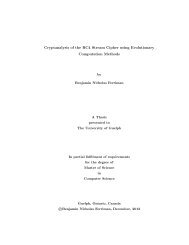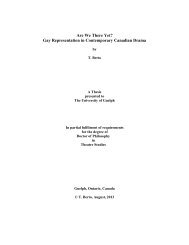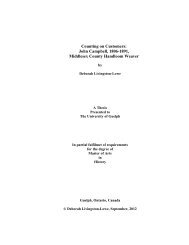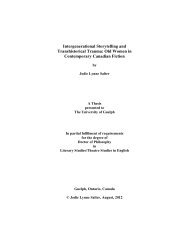THESIS - ROC CH ... - FINAL - resubmission.pdf - University of Guelph
THESIS - ROC CH ... - FINAL - resubmission.pdf - University of Guelph
THESIS - ROC CH ... - FINAL - resubmission.pdf - University of Guelph
Create successful ePaper yourself
Turn your PDF publications into a flip-book with our unique Google optimized e-Paper software.
through the use <strong>of</strong> enzymes have produced more favorable characteristics compared to<br />
hydrolysis treatments. For instance, Henriksson et al. (2007) produced nan<strong>of</strong>ibers with high<br />
molecular weights compared to mechanical and chemical methods. Janardhnan and Sain<br />
(2006) successfully obtained lower fiber diameters compared to acidic treatments using fungal<br />
culture OS1. The effectiveness <strong>of</strong> enzymatic treatments was attributed to its milder activity<br />
against cellulose where the cellulose fibrils were more intact in comparison to hydrolysis<br />
treatments.<br />
Mechanical extraction is achieved by refining, high-pressure homogenization,<br />
ultrasonication, and/or cryocrushing. Refining is similar to typical conventional paper making<br />
process except that rotating and stationary discs were used to compress and shear cellulose<br />
fibers to nano-scale dimensions. However this energy intensive method suffers a drawback that<br />
could yield aggregates <strong>of</strong> nano-sized particles rather than separated fiber strands (Hubbe et al.<br />
2008). In comparison, homogenization is a process that uses refined cellulose suspensions that<br />
are pumped through a small orifice at high pressures. As the fibers exit the orifice, the impact<br />
and shearing forces result in a high degree <strong>of</strong> fibrillation <strong>of</strong> cellulose fibers bundles (Siró and<br />
Plackett 2010). Many reports have had success resulting in the production <strong>of</strong> MFC with high<br />
aspect ratios; diameters between 20 to 100 nm and estimated lengths <strong>of</strong> tens <strong>of</strong> micrometers<br />
have been reported (López-Rubio et al. 2007; Wang and Sain 2007a). In ultrasonication, high<br />
resonating frequencies are used to generate shock waves in liquids. When applied to a<br />
cellulose suspension, the high speed impinging jets and strong hydrodynamic shear forces<br />
disintegrates the suspension into short fibers with nano-dimensions (Pääkkö et al. 2007; Wang<br />
et al. 2008). Cryocrushing is done first by swelling cellulose with water, immersing in liquid<br />
nitrogen, and then crushing it using a mortar and pestle. This is an effective method for de-<br />
lamination but could also yield fibers that are brittle and short due to the extreme freezing<br />
combined with intense mechanical forces (Hubbe et al. 2008).<br />
15

















